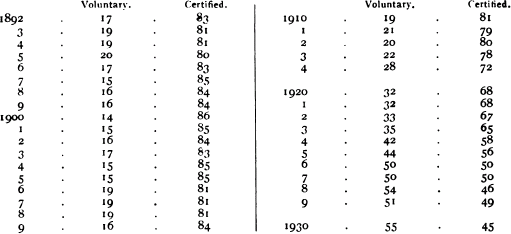No CrossRef data available.
Article contents
The Treatment of the Voluntary Boarder
The Retreat, York, 1891–1930
Published online by Cambridge University Press: 19 February 2018
Extract
The following paper is the result of experience gained during two and a half years' work at The Retreat, York.
It was prepared at the time that public attention was being focused upon the Mental Treatment Act, 1930. One of the most striking features of that Act was the provision that any person—pauper or otherwise—could be received into any mental hospital by applying for admission voluntarily. The removal of the bar of certification was widely welcomed; this welcome was believed by the writer to be partly a sentimental one. So little was known of any of the legal and medical difficulties which the voluntary boarder system had produced during the forty years it had been in fairly constant use in the registered mental hospitals, that these problems were seldom referred to when the Mental Treatment Act was under consideration.
- Type
- Part I.—Original Articles
- Information
- Copyright
- Copyright © Royal College of Psychiatrists, 1933
References
* 17th Report of the Commissioners in Lunacy, 1863, p. 108. Google Scholar
* 33rd Report of Commissioners in Lunacy, 1879, p. 137. Google Scholar
* 44th Report, 1890, p. 100. Google Scholar
* The following table shows the actual percentages of voluntary and certified admissions to all registered hospitals in England and Wales from 1892 to 1930. Figures for 1915-1919 are unobtainable:Google Scholar

* The results of treatment of persons who were certified and transferred to other hospitals are tabulated in the “Relieved” or “Not improved” columns. “Certified” only refers to those boarders who were certified at the Retreat and remained there. Google Scholar
* Melancholia, mania and the manic-depressive psychosis have been differentiated throughout. The writer believes that they form part of one great group, but he has purposely discriminated them. “Melancholia ”= those in whom no history of manic outbursts was found; “mania ”= those in whom no history of melancholic outbursts was found ; and “manic-depressive psychosis ” includes all those in whom alternating states were definitely known to have occurred. Google Scholar
† This represents the residue of those to whom no diagnosis could be attached. In a large number of the other cases great doubt has existed, and the writer realizes quite clearly that these would be open to question. Google Scholar
‡ Mental defectives and epileptics are not usually admitted to the Retreat. Google Scholar
* 24th Report of the Commissioners in Lunacy, 1870, p. 36. Google Scholar
* Mental defectives and epileptics are not usually admitted to the Retreat. Google Scholar
* The number of voluntary boarders who were certified and remained has been excluded from these percentages, as no counterpart to them occurs amongst cases who are certified during the whole of their stay at the Retreat. Google Scholar
* When the relatives were informed of this, a number of the 51 patients were transferred elsewhere, and some 20 were certified and remained. In the remaining cases the relatives refused, to allow certification, and the patient went home. Google Scholar





eLetters
No eLetters have been published for this article.